Intel Office :: 2
And let's get straight to the point. Most recently, I returned from Nizhny Novgorod, where I visited the Intel regional office. In addition to Habrahabr (represented by me), other projects, such as IXBT, Ferra, 3DNews, RIA Novosti, and other well-known publications, went to the "link across Russia".
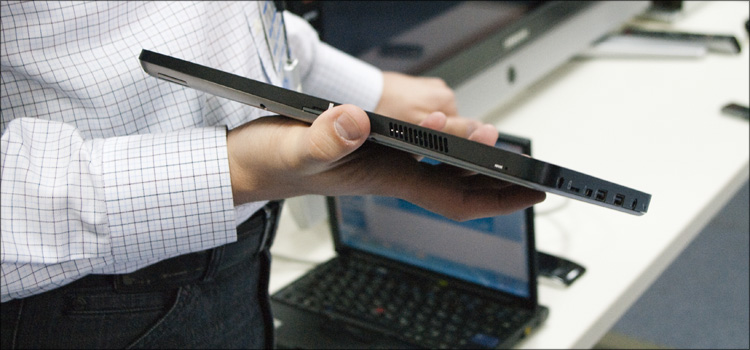
We all learned a lot about the company’s activities in Russia, which I want to do under the cut - the second attempt came out more detailed and interesting.
In fact, it was a regular press tour, which was combined with another event. I'm talking about the 3 days with Intel program», The advertisement of which you could see on the site; so with us there were also 5 winners of this event - the most ordinary people interested in IT, who did not hesitate to take part in the competition and did everything to win it. The competition, by the way, lasted six months, which allowed only those who were interested in this whole excursion to be selected.
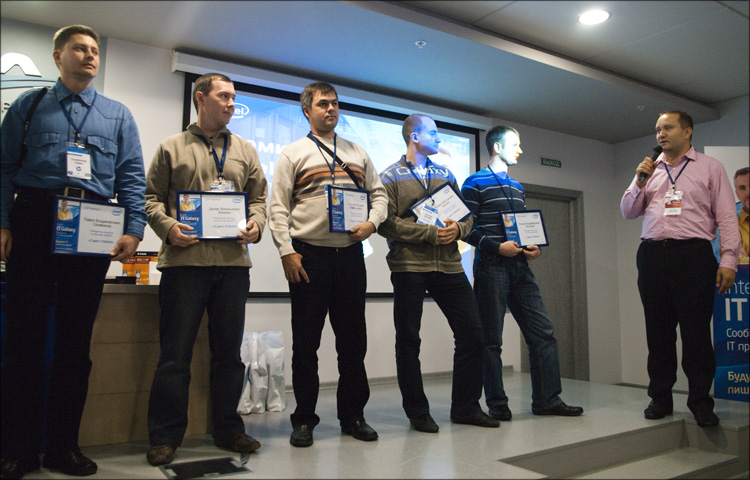
Intel Research and Development Center in Nizhny Novgorod was opened in May 2000 (I already wrote about the history of its discovery ) and is located at ul. Turgeneva, d. 30. In the terminology of the company there is such a thing as a “site” - a kind of synonym for the word “location”. Now the Nizhny Novgorod site employs about 450 people, who can be divided into the following groups:
 Information Technology (IT)- a fairly large group, which for the most part is engaged in supporting the operability of other units, is responsible for the infrastructure of the entire office.
Information Technology (IT)- a fairly large group, which for the most part is engaged in supporting the operability of other units, is responsible for the infrastructure of the entire office.
 Mobility Group (MG) are the very people who develop the hardware and software implementation of wireless Internet access. These people, for example, are directly involved in the development of 802.11 and 802.16 standards.
Mobility Group (MG) are the very people who develop the hardware and software implementation of wireless Internet access. These people, for example, are directly involved in the development of 802.11 and 802.16 standards.
 Software and Services Group (SSG)- the largest group in Nizhny Novgorod (about 270 people out of 450). They are mainly engaged in the development of software products: Intel optimizers and compilers, libraries for improving performance, digital signal processing and image visualization, development of a multi-processor and multi-threaded programming system, issues of parallelization of computations. One of the most important projects underway within the walls of the Nizhny Novgorod laboratory can rightfully be called Intel Parallel Studio , the second version of which was released recently.
Software and Services Group (SSG)- the largest group in Nizhny Novgorod (about 270 people out of 450). They are mainly engaged in the development of software products: Intel optimizers and compilers, libraries for improving performance, digital signal processing and image visualization, development of a multi-processor and multi-threaded programming system, issues of parallelization of computations. One of the most important projects underway within the walls of the Nizhny Novgorod laboratory can rightfully be called Intel Parallel Studio , the second version of which was released recently.
 Sales and Marketing Group (SMG) - engaged in supporting customers of the company, including outside the Russian Federation.
Sales and Marketing Group (SMG) - engaged in supporting customers of the company, including outside the Russian Federation.
 Manufacturing Technology Group (TMG)- A small group engaged in research in the field of semiconductors and optics. Other areas of scientific research include the study and creation of probabilistic graphical models, the creation of machine learning libraries, video monitoring technologies (detection of video image defects), and wireless data transfer technologies.
Manufacturing Technology Group (TMG)- A small group engaged in research in the field of semiconductors and optics. Other areas of scientific research include the study and creation of probabilistic graphical models, the creation of machine learning libraries, video monitoring technologies (detection of video image defects), and wireless data transfer technologies.
 Administrative and economic group - accounting, personnel department, department of external relations, etc.
Administrative and economic group - accounting, personnel department, department of external relations, etc.
I would like to dwell in more detail on the group of information technologies (IT), namely the support service. One of the tasks of this unit is to achieve maximum productivity and efficiency of work processes. And succeeding in all this is not so easy, especially when it comes to the entire corporation as a whole. Some statistics: about 80,000 employees of the corporation account for about 90,000 computers (80% of which are laptops). To this fleet of serviced equipment, you can add about 7000 access points and about 14000 handheld devices (smartphones, communicators), with which many employees gain access to corporate information, thereby increasing their mobility. Of the entire state, the IT group accounts for about 6,300 people located in 25 regions (in 63 offices). These people also have at their disposal 95 data centers (with a total area of more than 38,000 square meters and with a total consumption of 55 MW), i.e. a huge number of servers (about 100,000 in more than 5,000 racks) with large computing power. More than 177 million email messages go through the company's servers per month. Here.
Our tour of the company building was accompanied by very rich technical seminars, some of which I’m trying to share.
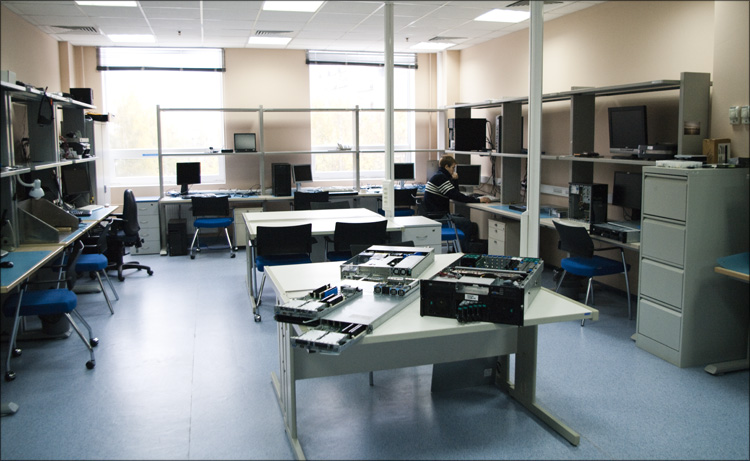
It was interesting to visit one of the office laboratories involved in testing equipment for the provision of service consultations for system integrators. This is the only laboratory in Russia and the CIS countries (a similar one is only in England), which has a full range of Intel products (server and desktop systems) released over the past few years - right up to the different revisions of each product! Thanks to this, it is possible to provide unique customers (integrators) with a unique service, recreating most of the necessary configurations directly in the laboratory.
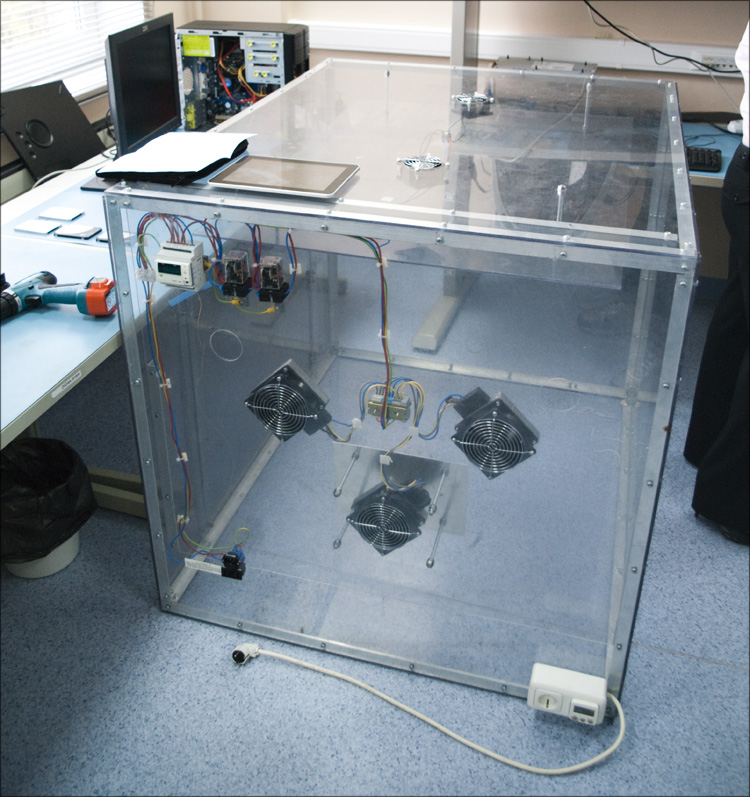

The company's engineers test them by various means for software compatibility and performance under different conditions, so that by the time of the announcement and the start of delivery of these new products, the company's technical support can not only comprehensively cover various aspects of the application, but also give advice on practical integration in production, conduct technical seminars and training on new products and technologies.

They talked for a long and interesting time about an equally interesting development - the Remote Lab (Remote Lab), which makes it possible to test new products for interested customers via the Internet, providing access to modern equipment and engineering samples. This approach allows you to know in advance about the performance of new devices, their compatibility with various products, but at the same time reduce the risks and time for integration; This function is especially relevant before launching new products - when officially they aren’t anywhere else, but especially interested customers already have the ability to remotely spin-turn the novelty. Additionally - the ability to organize online seminars and training, regardless of the distance to the client.
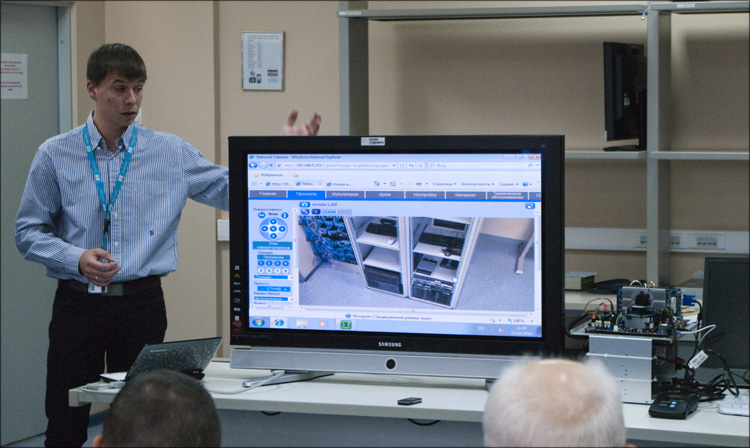
In addition to the server side, the laboratory also has a division specializing in netbooks, "tablets" and other mobile systems.
Within the walls of the laboratory, we were told about some prospects and aspects of the new MeeGo operating system (you can read here ), as well as Intel Atom processors, reinforcing words with various demonstrations. So, for example, they clearly showed the difference in the boot time of two identical netbooks running under different operating systems.
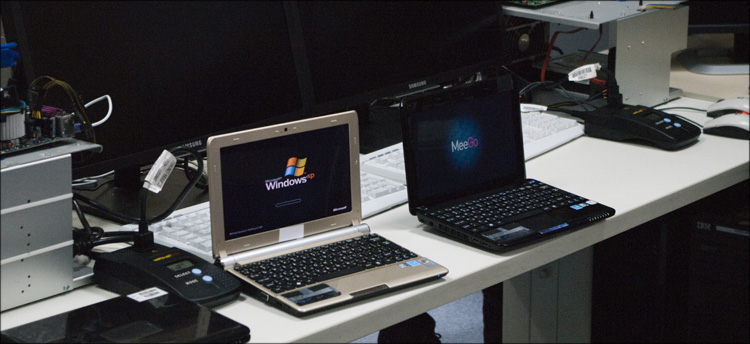
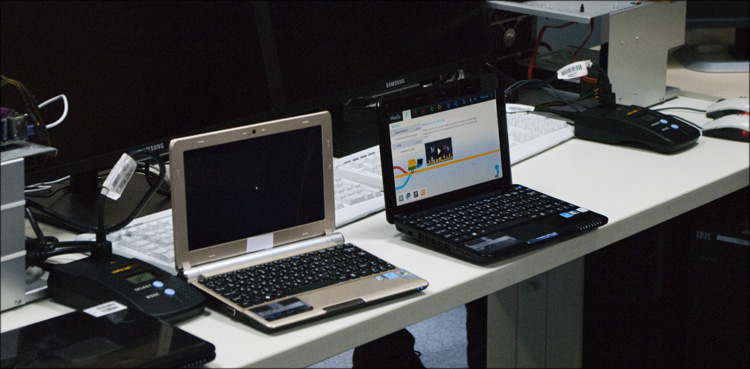
It also turned out that modern platforms based on the new Intel Atom with much less (at times) power consumption decently outperform the speed of the system on the once-top Intel Pentium 4 processors and their corresponding discrete cards. Maybe this is not the most correct comparison, but the difference in megahertz and consumed watts is indicative.

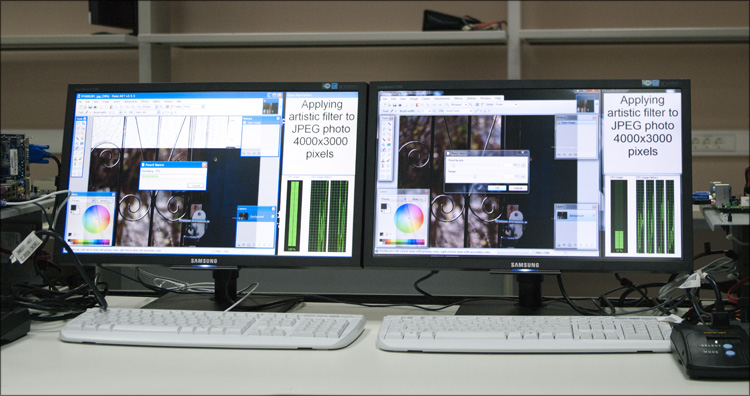
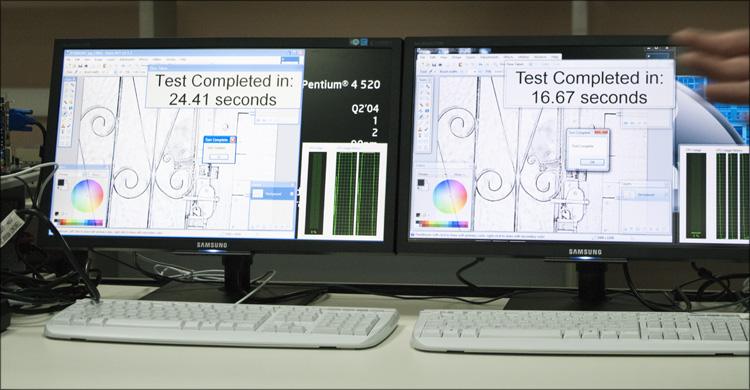
As a bonus, a non-branded prototype tablet based on MeeGo was shown, a review of which I will try to do in the very near future
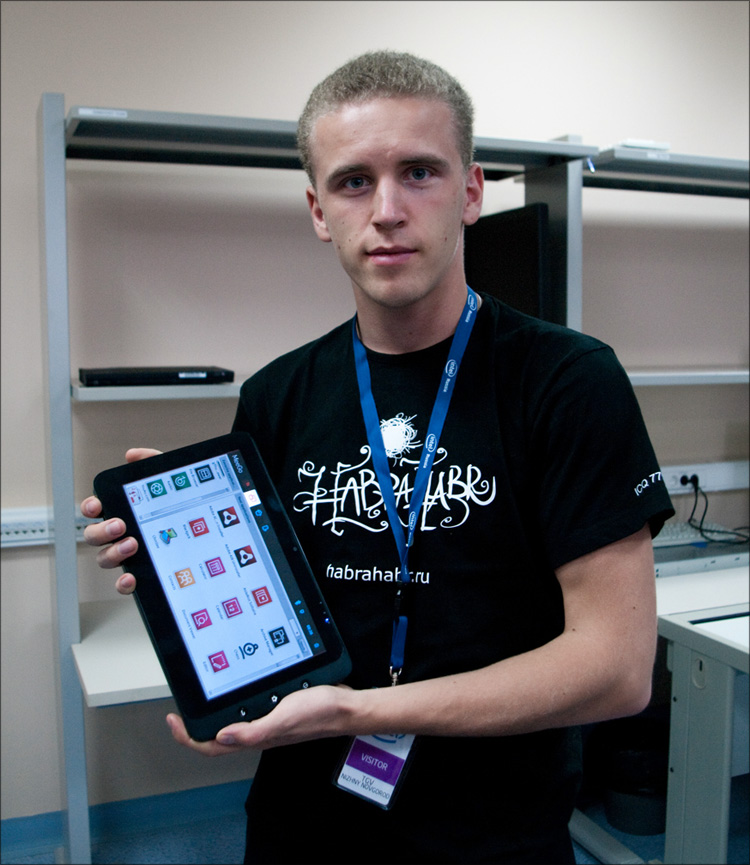
Our arrival in the building began with the passage of the security checkpoint - there we were given plastic visitor badges. This was followed by a safety briefing - told how and where to run.
At hand, a wireless network was found (the signal is caught all over the building), but it’s strictly connected to the Internet - it just won’t be able to log in and sit on the Wi-Fi network. For each representative of the press, a separate account was created for 1 day, with a complex login and password. But, according to employees, you can get access to most of the internal information necessary for work from home, through an encrypted vpn channel.
On one floor, a small bonus room was found for relaxation, in which there was a game console, table football, an electronic "plate" installation and a stack of various IT magazines that can be read on the couch. On some walls are large boards on which printed articles from various sites are hung. I expressed my dissatisfaction with the absence of Habr and seemed to promise to correct this misunderstanding :) Well, well, it's not just about Intel that I write.
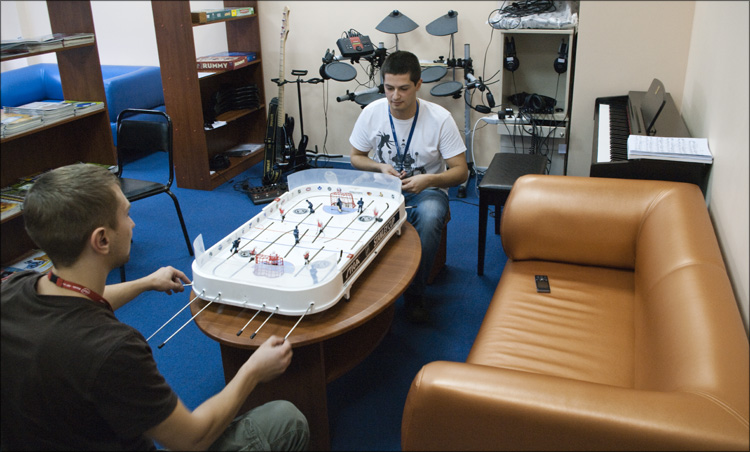
The walls of one of the floors are decorated with respect and respect. I especially remember this one: “ ICANN - International Community Association of Nizhny Novgorod ” :)
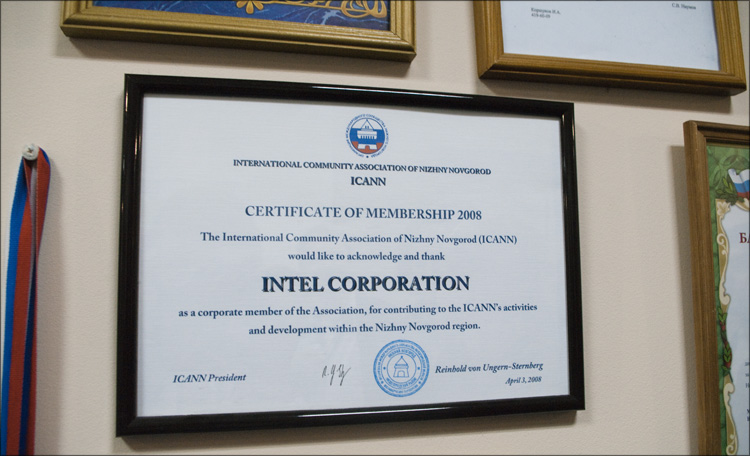
On each floor there is a small “snack bar” where there is always tea and coffee and something else. Surprised hanging bags with a medical disinfectant gel - in case there is no way to wash your hands. They say they appeared not so long ago, when news about all sorts of viruses and other misfortunes scattered on the news.
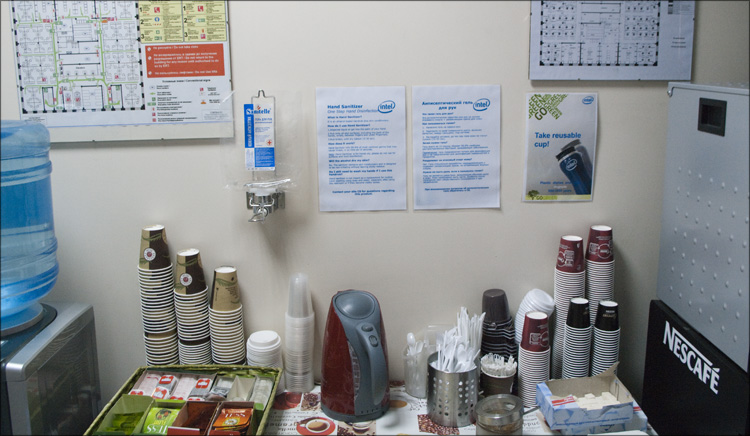
At unregulated intersections of the office territory, "general view mirrors" are fixed on the ceilings, in which everything is visible and even a little more. This is in case two people (or wall to wall) do not crash and, for example, do not douse each other with hot tea. Well, or hot coffee.

Surprised cabinets with the inscription "ORT". Here you will never guess what is in them! the canal has nothing to do with it - inside there is a variety of fire ammunition designed for volunteer firefighters. Everything is new, everything is charged and ready for battle) Does anyone remember the last time he had evacuation training at work in the event of a fire? I vaguely remember such an event only from my school years ... here all this is practiced with enviable constancy - the maximum time for the evacuation of all people up the stairs is 8 minutes (80-90% of which go out in the first 3-5 minutes). Periodically appearing auditors (in the person of various instances) do not find any shortcomings, on the contrary, praise for the exemplary approach.
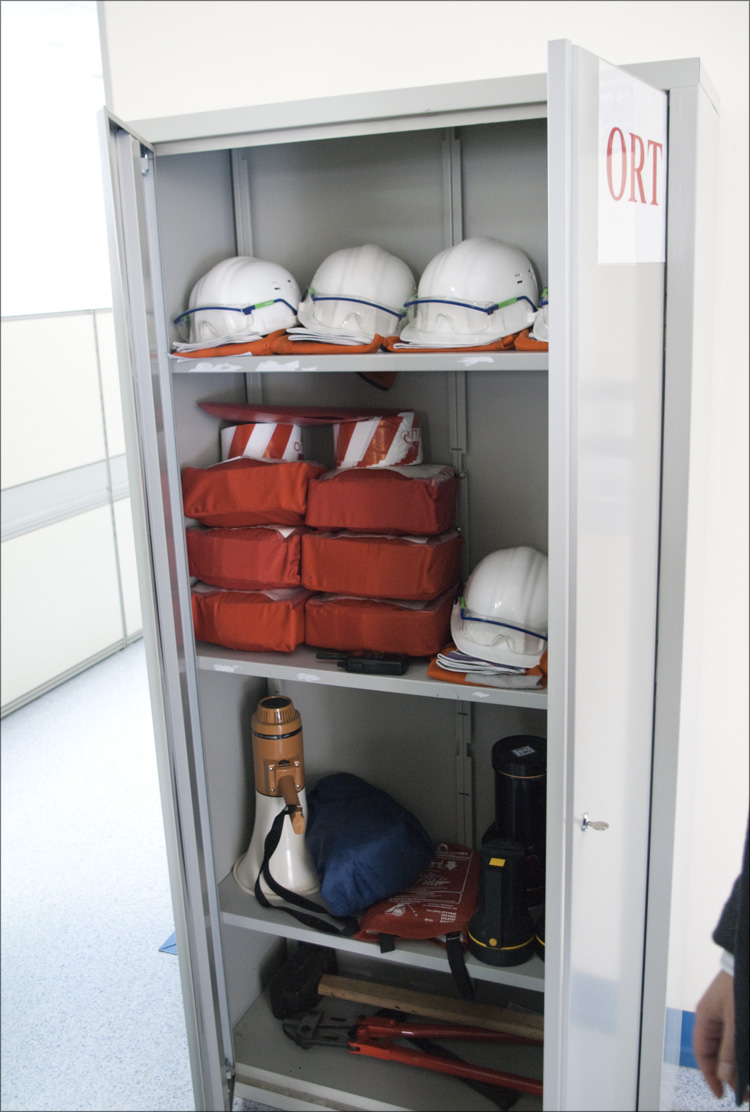
We went outside where it was cold and damp.
It turns out that Mercedes is not only “ce-el-ka” and “gelika”, but also a 700-kilowatt diesel generator! At least that's what it stands in a small extension on the ground floor. In the event of an emergency, the generator is able for about a day (without the supply of additional fuel) to fully provide electricity to the most important areas of the office, including all infrastructure elements, such as telephones, Internet cameras, etc.). Such a monster eats about 100 liters of fuel per hour and starts about 30 seconds, and the suitability for operation is checked every month. The total energy consumption of the entire office is about 2 MW.
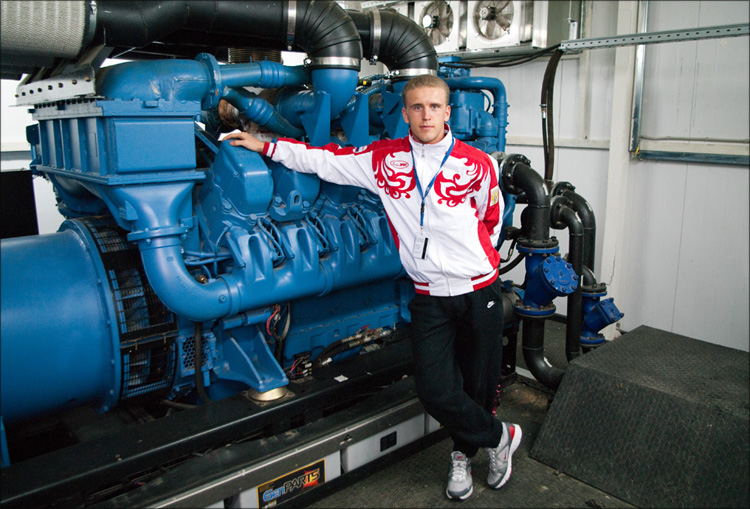
There are two floors of armored windows above the generator, in case it “cracks” - so that no one is hurt. There is also a separate room with a large number of UPSs (or batteries for them), on the total charge of which the office can work for about 30 minutes.
The external building cooling system (fan coils) is buzzing very close by, blowing heat from the electronics working in the building (as I understand it, it was about the data center). In the future, they want to improve this process and direct the “blown” heat along the second circle for heating hot water and other needs. In winter, when it’s cold, part of the cooling units is turned off and the servers are cooled due to the environment through another tricky system. This approach allows you to save a huge amount of energy / money - I don’t remember the exact order, but we are talking about tens / hundreds of thousands of $. Evgeny Kozlovsky joked subtly - “ And you take these cooling units out of the Arctic Circle, save even more ” :)

Around the building there is a fairly large paved area, it is also parking for company employees (for those who come by bike and motorcycle, there is a separate section with a canopy). Apparently, the far corner of this particular site is the safest in case of evacuation. There are a few horizontal bars (I saw only parallel bars) and a basketball court. There was a lack of greenery (compared, for example, with the Moscow office; perhaps this is due to the time of year), but they said that they would work on this issue, but for now - more priority tasks.
On the land owned by the company, it is possible to build a second similar building (already with underground parking), but this is not necessary for the next few years.
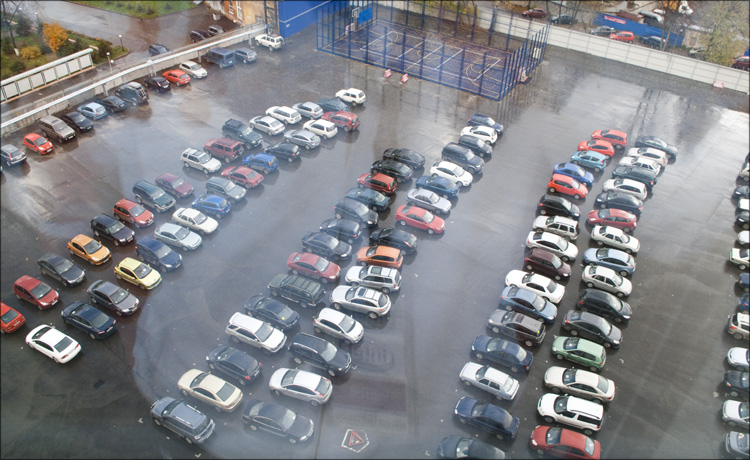
They returned to the building again to warm themselves. Actually, we noticed the dining room and decided to glance there out of the corner of the eye) It's nothing unusual except that inside there is one public (for office) camera, through the web interface of which you can evaluate the scale of the queue at any time. This was done so as not to run back and forth once again and not to waste time. On leaving the dining room, I noticed the black-and-yellow rectangular contours around almost every door - "you aren’t hady, otherwise the door is papadot!" Offset.
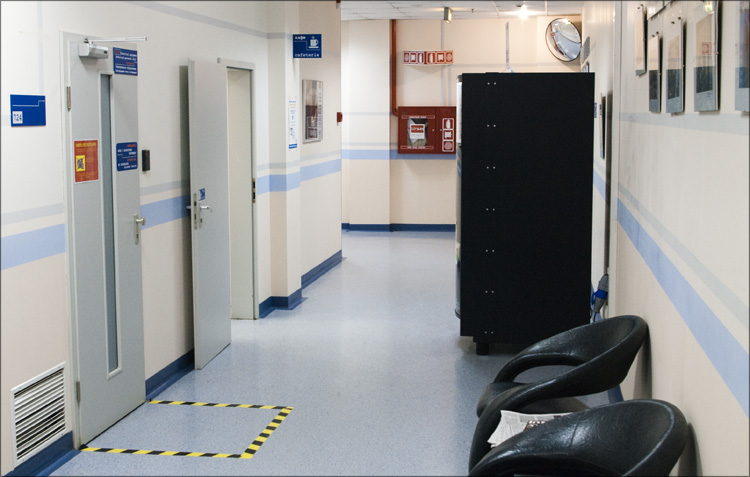
Perhaps that's all for today. After partying at the office and laboratories, we began to prepare for another interesting event, which I will talk about next time.
Good luck!

We all learned a lot about the company’s activities in Russia, which I want to do under the cut - the second attempt came out more detailed and interesting.
In fact, it was a regular press tour, which was combined with another event. I'm talking about the 3 days with Intel program», The advertisement of which you could see on the site; so with us there were also 5 winners of this event - the most ordinary people interested in IT, who did not hesitate to take part in the competition and did everything to win it. The competition, by the way, lasted six months, which allowed only those who were interested in this whole excursion to be selected.

Intel Research and Development Center in Nizhny Novgorod was opened in May 2000 (I already wrote about the history of its discovery ) and is located at ul. Turgeneva, d. 30. In the terminology of the company there is such a thing as a “site” - a kind of synonym for the word “location”. Now the Nizhny Novgorod site employs about 450 people, who can be divided into the following groups:
 Information Technology (IT)- a fairly large group, which for the most part is engaged in supporting the operability of other units, is responsible for the infrastructure of the entire office.
Information Technology (IT)- a fairly large group, which for the most part is engaged in supporting the operability of other units, is responsible for the infrastructure of the entire office.  Mobility Group (MG) are the very people who develop the hardware and software implementation of wireless Internet access. These people, for example, are directly involved in the development of 802.11 and 802.16 standards.
Mobility Group (MG) are the very people who develop the hardware and software implementation of wireless Internet access. These people, for example, are directly involved in the development of 802.11 and 802.16 standards.  Software and Services Group (SSG)- the largest group in Nizhny Novgorod (about 270 people out of 450). They are mainly engaged in the development of software products: Intel optimizers and compilers, libraries for improving performance, digital signal processing and image visualization, development of a multi-processor and multi-threaded programming system, issues of parallelization of computations. One of the most important projects underway within the walls of the Nizhny Novgorod laboratory can rightfully be called Intel Parallel Studio , the second version of which was released recently.
Software and Services Group (SSG)- the largest group in Nizhny Novgorod (about 270 people out of 450). They are mainly engaged in the development of software products: Intel optimizers and compilers, libraries for improving performance, digital signal processing and image visualization, development of a multi-processor and multi-threaded programming system, issues of parallelization of computations. One of the most important projects underway within the walls of the Nizhny Novgorod laboratory can rightfully be called Intel Parallel Studio , the second version of which was released recently.  Sales and Marketing Group (SMG) - engaged in supporting customers of the company, including outside the Russian Federation.
Sales and Marketing Group (SMG) - engaged in supporting customers of the company, including outside the Russian Federation.  Manufacturing Technology Group (TMG)- A small group engaged in research in the field of semiconductors and optics. Other areas of scientific research include the study and creation of probabilistic graphical models, the creation of machine learning libraries, video monitoring technologies (detection of video image defects), and wireless data transfer technologies.
Manufacturing Technology Group (TMG)- A small group engaged in research in the field of semiconductors and optics. Other areas of scientific research include the study and creation of probabilistic graphical models, the creation of machine learning libraries, video monitoring technologies (detection of video image defects), and wireless data transfer technologies.  Administrative and economic group - accounting, personnel department, department of external relations, etc.
Administrative and economic group - accounting, personnel department, department of external relations, etc.I would like to dwell in more detail on the group of information technologies (IT), namely the support service. One of the tasks of this unit is to achieve maximum productivity and efficiency of work processes. And succeeding in all this is not so easy, especially when it comes to the entire corporation as a whole. Some statistics: about 80,000 employees of the corporation account for about 90,000 computers (80% of which are laptops). To this fleet of serviced equipment, you can add about 7000 access points and about 14000 handheld devices (smartphones, communicators), with which many employees gain access to corporate information, thereby increasing their mobility. Of the entire state, the IT group accounts for about 6,300 people located in 25 regions (in 63 offices). These people also have at their disposal 95 data centers (with a total area of more than 38,000 square meters and with a total consumption of 55 MW), i.e. a huge number of servers (about 100,000 in more than 5,000 racks) with large computing power. More than 177 million email messages go through the company's servers per month. Here.
Our tour of the company building was accompanied by very rich technical seminars, some of which I’m trying to share.

It was interesting to visit one of the office laboratories involved in testing equipment for the provision of service consultations for system integrators. This is the only laboratory in Russia and the CIS countries (a similar one is only in England), which has a full range of Intel products (server and desktop systems) released over the past few years - right up to the different revisions of each product! Thanks to this, it is possible to provide unique customers (integrators) with a unique service, recreating most of the necessary configurations directly in the laboratory.


The company's engineers test them by various means for software compatibility and performance under different conditions, so that by the time of the announcement and the start of delivery of these new products, the company's technical support can not only comprehensively cover various aspects of the application, but also give advice on practical integration in production, conduct technical seminars and training on new products and technologies.

They talked for a long and interesting time about an equally interesting development - the Remote Lab (Remote Lab), which makes it possible to test new products for interested customers via the Internet, providing access to modern equipment and engineering samples. This approach allows you to know in advance about the performance of new devices, their compatibility with various products, but at the same time reduce the risks and time for integration; This function is especially relevant before launching new products - when officially they aren’t anywhere else, but especially interested customers already have the ability to remotely spin-turn the novelty. Additionally - the ability to organize online seminars and training, regardless of the distance to the client.

In addition to the server side, the laboratory also has a division specializing in netbooks, "tablets" and other mobile systems.
Within the walls of the laboratory, we were told about some prospects and aspects of the new MeeGo operating system (you can read here ), as well as Intel Atom processors, reinforcing words with various demonstrations. So, for example, they clearly showed the difference in the boot time of two identical netbooks running under different operating systems.


It also turned out that modern platforms based on the new Intel Atom with much less (at times) power consumption decently outperform the speed of the system on the once-top Intel Pentium 4 processors and their corresponding discrete cards. Maybe this is not the most correct comparison, but the difference in megahertz and consumed watts is indicative.



As a bonus, a non-branded prototype tablet based on MeeGo was shown, a review of which I will try to do in the very near future

Office tour
Our arrival in the building began with the passage of the security checkpoint - there we were given plastic visitor badges. This was followed by a safety briefing - told how and where to run.
At hand, a wireless network was found (the signal is caught all over the building), but it’s strictly connected to the Internet - it just won’t be able to log in and sit on the Wi-Fi network. For each representative of the press, a separate account was created for 1 day, with a complex login and password. But, according to employees, you can get access to most of the internal information necessary for work from home, through an encrypted vpn channel.
On one floor, a small bonus room was found for relaxation, in which there was a game console, table football, an electronic "plate" installation and a stack of various IT magazines that can be read on the couch. On some walls are large boards on which printed articles from various sites are hung. I expressed my dissatisfaction with the absence of Habr and seemed to promise to correct this misunderstanding :) Well, well, it's not just about Intel that I write.

The walls of one of the floors are decorated with respect and respect. I especially remember this one: “ ICANN - International Community Association of Nizhny Novgorod ” :)

On each floor there is a small “snack bar” where there is always tea and coffee and something else. Surprised hanging bags with a medical disinfectant gel - in case there is no way to wash your hands. They say they appeared not so long ago, when news about all sorts of viruses and other misfortunes scattered on the news.

At unregulated intersections of the office territory, "general view mirrors" are fixed on the ceilings, in which everything is visible and even a little more. This is in case two people (or wall to wall) do not crash and, for example, do not douse each other with hot tea. Well, or hot coffee.

Surprised cabinets with the inscription "ORT". Here you will never guess what is in them! the canal has nothing to do with it - inside there is a variety of fire ammunition designed for volunteer firefighters. Everything is new, everything is charged and ready for battle) Does anyone remember the last time he had evacuation training at work in the event of a fire? I vaguely remember such an event only from my school years ... here all this is practiced with enviable constancy - the maximum time for the evacuation of all people up the stairs is 8 minutes (80-90% of which go out in the first 3-5 minutes). Periodically appearing auditors (in the person of various instances) do not find any shortcomings, on the contrary, praise for the exemplary approach.

We went outside where it was cold and damp.
It turns out that Mercedes is not only “ce-el-ka” and “gelika”, but also a 700-kilowatt diesel generator! At least that's what it stands in a small extension on the ground floor. In the event of an emergency, the generator is able for about a day (without the supply of additional fuel) to fully provide electricity to the most important areas of the office, including all infrastructure elements, such as telephones, Internet cameras, etc.). Such a monster eats about 100 liters of fuel per hour and starts about 30 seconds, and the suitability for operation is checked every month. The total energy consumption of the entire office is about 2 MW.

There are two floors of armored windows above the generator, in case it “cracks” - so that no one is hurt. There is also a separate room with a large number of UPSs (or batteries for them), on the total charge of which the office can work for about 30 minutes.
The external building cooling system (fan coils) is buzzing very close by, blowing heat from the electronics working in the building (as I understand it, it was about the data center). In the future, they want to improve this process and direct the “blown” heat along the second circle for heating hot water and other needs. In winter, when it’s cold, part of the cooling units is turned off and the servers are cooled due to the environment through another tricky system. This approach allows you to save a huge amount of energy / money - I don’t remember the exact order, but we are talking about tens / hundreds of thousands of $. Evgeny Kozlovsky joked subtly - “ And you take these cooling units out of the Arctic Circle, save even more ” :)

Around the building there is a fairly large paved area, it is also parking for company employees (for those who come by bike and motorcycle, there is a separate section with a canopy). Apparently, the far corner of this particular site is the safest in case of evacuation. There are a few horizontal bars (I saw only parallel bars) and a basketball court. There was a lack of greenery (compared, for example, with the Moscow office; perhaps this is due to the time of year), but they said that they would work on this issue, but for now - more priority tasks.
On the land owned by the company, it is possible to build a second similar building (already with underground parking), but this is not necessary for the next few years.

They returned to the building again to warm themselves. Actually, we noticed the dining room and decided to glance there out of the corner of the eye) It's nothing unusual except that inside there is one public (for office) camera, through the web interface of which you can evaluate the scale of the queue at any time. This was done so as not to run back and forth once again and not to waste time. On leaving the dining room, I noticed the black-and-yellow rectangular contours around almost every door - "you aren’t hady, otherwise the door is papadot!" Offset.

Perhaps that's all for today. After partying at the office and laboratories, we began to prepare for another interesting event, which I will talk about next time.
Good luck!
